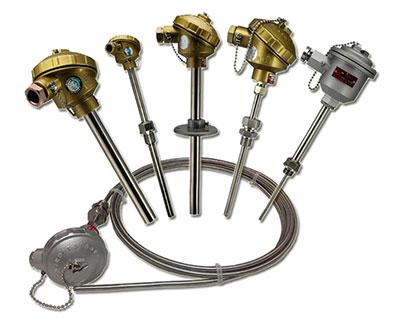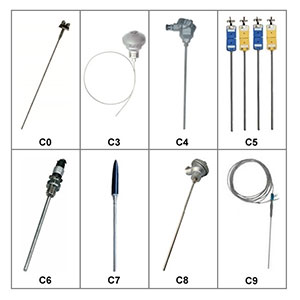Thermocouple Selection Guide
Temperature measurement is a critical aspect of various industrial and scientific applications. Whether it's monitoring the temperature of a chemical process, ensuring safety in a petrochemical plant, or conducting high-precision experiments in a laboratory, selecting the right temperature sensor is paramount. One of the most popular and versatile choices for temperature measurement is the thermocouple. However, with various types and characteristics to consider, choosing the right thermocouple can be a daunting task. This article serves as a comprehensive guide to help you navigate the process of thermocouple selection effectively.
How to Choose
- Understanding Thermocouples
Thermocouples are temperature sensors based on the Seebeck effect, which produces a voltage when two dissimilar metals are joined at one end and subjected to a temperature gradient. The voltage generated is proportional to the temperature difference between the hot junction and the cold junction, making thermocouples ideal for a wide range of temperature measurement applications. - Define Your Temperature Range and Accuracy Requirements
The first step in selecting a thermocouple is to define the temperature range you need to measure. Each thermocouple type has a specific range, so understanding the minimum and maximum temperatures in your application is crucial. Additionally, consider the required level of accuracy. Some applications demand high precision, while others allow for more leniency. - Evaluate Environmental Conditions
The environment in which the thermocouple will operate plays a crucial role in selection. Factors to consider include:
Corrosive or abrasive substances: Some thermocouples are better suited to resist chemical attack.
Vibrations and mechanical stress: Choose a robust thermocouple for harsh environments.
Electromagnetic interference: Certain applications, such as those in the presence of strong electromagnetic fields, require careful consideration.
- Budget and Availability
Different thermocouple types vary in cost, and availability might be limited for some. Determine your budget and ensure the chosen thermocouple is readily accessible. - Application-Specific Factors
Certain applications have unique requirements that should guide thermocouple selection:
Response time: Some thermocouples respond faster to temperature changes than others.
Sensitivity: Consider whether you need to detect small temperature variations.
Size and installation: Ensure the thermocouple physically fits your system.
Longevity and stability: Some applications require measurements to remain stable over extended periods. - Choose the Right Thermocouple Type
Based on the above considerations, select the thermocouple type that aligns with your requirements. Common thermocouple types include Type K (Chromel-Alumel), Type J (Iron-Constantan), Type T (Copper-Constantan), and many others, each suited to specific temperature ranges and environmental conditions. - Cold Junction Compensation
Thermocouples rely on a reference temperature point known as the cold junction. Ensure that you account for this in your measurements through cold junction compensation, either using specialized hardware or an isothermal block. - Calibration
Calibration is essential, as thermocouples have non-linear characteristics. This step guarantees accurate temperature measurements according to your specific application needs. - Proper Connection and Wiring
Use suitable materials and techniques when connecting the thermocouple to the measuring instrument. Follow recommended color codes for thermocouple wires to avoid errors. - Safety Considerations
In some applications, safety is paramount. Ensure that your chosen thermocouple is suitable for your application, and consider the need for explosion-proof or intrinsically safe thermocouples. - Ongoing Maintenance
Some thermocouple types may be more prone to drift and require regular recalibration or replacement. Establish a maintenance plan to guarantee continued accuracy in your temperature measurements.
Notes for Selection
- If the sealing surface of the selected flange is concave convex or grooved, the form provided by the instrument is a convex flange.
- The sealing embedded welding method is mainly used for temperature measurement of highly corrosive media, which can save the cost of flanges. Due to the general use of straight welded pipes and only single sided welds, it is also used in situations where temperature and pressure are not high.
- Loose flange can be used in situations of strong corrosion, high temperature, and high pressure due to the fact that the bee surface of the liquid connection is processed into an integral part with the protective tube, and most of it adopts an integral drilling structure.

- The standards and specifications for selecting flanges are determined by the user based on the installation size and process conditions of the host equipment. Currently, there are three types of flange standards used internationally.
- The nominal pressure of the selected flange should not be greater than the nominal pressure of the protective pipe, and it will vary depending on the selected material and usage temperature.
- The diameter DN value in the selection table should be selected based on the insertion depth. When the protective tube is long (when L>200mm), the larger value should be appropriately taken through DN (Dg).
- For situations where the strength and reliability of the connection between a single welded fixed flange and a protective tube are highly required, a structure with thread fixation followed by ring welding can be supplied (the size of the connection thread is determined by the manufacturer and is a straight thread). When ordering, the word "thread reinforcement" can be added after the code.
Selecting the right thermocouple is a critical decision that can significantly impact the success of your temperature measurement application. By considering temperature range, accuracy, environmental conditions, and application-specific factors, you can make an informed choice. Furthermore, ensure that calibration, proper wiring are all part of your thermocouple management plan. In doing so, you can rely on accurate and consistent temperature measurements for your unique needs.

